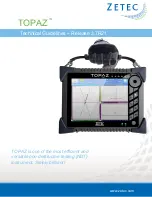
6-4
Troubleshooting
3. Remove the PIO-HV board from the computer and visually check for
damage. If a board is obviously damaged, refer to “Technical
Support” on page 6-5 for information on returning the board.
4. With the PIO-HV board out of the computer, check the computer for
proper operation. Power up the computer and perform any necessary
diagnostics.
At this point, if you have another PIO-HV board you know is functional,
you can test the slot and I/O connections using the instructions in the next
section. If you do not have another board, refer to the instructions on
“Technical Support” on page 6-5 before calling Keithley Technical
Support.
Testing the Accessory Slot and I/O Connections
When you are sure that the computer is operating properly, test the
computer accessory slot and I/O connections using another PIO-HV
board that you know is functional. To test the computer accessory slot and
the I/O connections, follow these steps:
1. Remove computer power again, and install a PIO-HV board you
know is functional. Do not make any I/O connections.
2. Turn computer power ON and check operation with the functional
board in place. This test checks the computer accessory slot. If you
were using more than one PIO-HV board when the problem
occurred, use the functional board to test the other slot, as well.
3. If the accessory slots are functional, use the functional board to
check the I/O connections. Reconnect and check the operation of the
I/O connections, one at a time.
4. If operation fails for an I/O connection, check the individual inputs
one at a time for shorts and opens.
5. If operation remains normal to this point, the problem is in the
PIO-HV board(s) originally in the computer. If you were using more
than one board, try each board one at a time in the computer to
determine which is faulty.
6. If you cannot isolate the problem, refer to the next section for
instructions on obtaining assistance.
Artisan Technology Group - Quality Instrumentation ... Guaranteed | (888) 88-SOURCE | www.artisantg.com












































